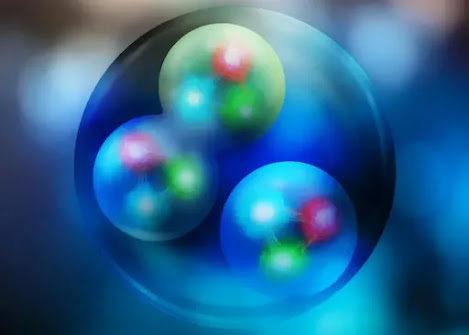Particle Physics Surprise: Nucleons Pick Pair Partners Differently in Small Nuclei
International Conference on Nuclear Physics
When odds are equal, particles paired up with others of the same kind more often than once thought.
The protons and neutrons, which make up the atom’s nucleus, frequently pair up. Now, a new high-precision experiment has found that these particles may pick different partners depending on how packed the nucleus is. The work was conducted at the U.S. Department of Energy’s Thomas Jefferson National Accelerator Facility.
The findings also reveal new details about short-distance interactions between protons and neutrons in nuclei and may impact results from experiments seeking to tease out deeper details of nuclear structure. The data are an order of magnitude more precise than in previous studies, and the research will be published today (August 31, 2022) in the journal Nature.
Shujie Li is the lead author on the paper. She is a nuclear physics postdoctoral researcher at the DOE’s Lawrence Berkeley National Laboratory in Berkeley, California and began work on the experiment as a graduate student at the University of New Hampshire. Li said the experiment was designed to compare fleeting partnerships between protons and neutrons, called short-range correlations, in small nuclei.
This experiment compared the prevalence of each type of short-range correlation in the so-called mirror nuclei of helium-3 and tritium, an isotope of hydrogen. These nuclei each contain three nucleons. They are considered “mirror nuclei” because each one’s proton content mirrors the other’s neutron content.
“Tritium is one proton and two neutrons, and helium-3 is two protons and one neutron. By comparing tritium and helium-3, we can assume that neutron-proton pairs in tritium are the same as neutron-proton pairs in helium- 3. And tritium can make one additional neutron-neutron pair, and helium-3 can make one additional proton-proton pair,” Li explained.
Taken together, the data from both nuclei reveal how often nucleons pair up with others like themselves versus those that are different.
“The simple idea is just to compare how many pairs the two nuclei have in each configuration,” she said.
The findings also reveal new details about short-distance interactions between protons and neutrons in nuclei and may impact results from experiments seeking to tease out deeper details of nuclear structure. The data are an order of magnitude more precise than in previous studies, and the research will be published today (August 31, 2022) in the journal Nature.
Shujie Li is the lead author on the paper. She is a nuclear physics postdoctoral researcher at the DOE’s Lawrence Berkeley National Laboratory in Berkeley, California and began work on the experiment as a graduate student at the University of New Hampshire. Li said the experiment was designed to compare fleeting partnerships between protons and neutrons, called short-range correlations, in small nuclei
Protons and neutrons are collectively called nucleons. When they’re involved in short-range correlations, nucleons briefly overlap before they fly apart with high momentum. Correlations may form between a proton and a neutron, between two protons, or between two neutrons.
This experiment compared the prevalence of each type of short-range correlation in the so-called mirror nuclei of helium-3 and tritium, an isotope of hydrogen. These nuclei each contain three nucleons. They are considered “mirror nuclei” because each one’s proton content mirrors the other’s neutron content.
“Tritium is one proton and two neutrons, and helium-3 is two protons and one neutron. By comparing tritium and helium-3, we can assume that neutron-proton pairs in tritium are the same as neutron-proton pairs in helium- 3. And tritium can make one additional neutron-neutron pair, and helium-3 can make one additional proton-proton pair,” Li explained.
Taken together, the data from both nuclei reveal how often nucleons pair up with others like themselves versus those that are different.
“The simple idea is just to compare how many pairs the two nuclei have in each configuration,” she said.
“We’re still making new measurements in familiar nuclei that are relevant to the nuclear structure and finding surprises. So the fact that we’re still finding surprises on a simple nucleus is very interesting,” Arrington commented. “We really want to understand where it comes from, because it has to tell us something about the way that the nucleons interact at short distance, which is hard to measure anywhere other than Jefferson Lab.”
This experiment was conducted in Jefferson Lab’s Continuous Electron Beam Accelerator Facility (CEBAF), an Office of Science user facility, in its Experimental Hall A. It featured a unique tritium target that was designed for a series of rare experiments, and it used a different tactic to capture a dataset that is a factor of 10 more precise than earlier experiments: measuring just the electrons that bounced off of a correlated nucleon inside the mirror nuclei.
The nuclear physicists want to follow up this intriguing result with additional measurements in heavier nuclei. The earlier experiments in these nuclei used high-energy electrons generated in CEBAF. The electrons bounced from protons or neutrons engaged in a short-range correlation and the “the triple coincidence” of the outgoing electron, knocked-out proton and correlated partner was measured.
One challenge for this type of two-nucleon short-range correlation measurement is catching all three particles. Yet, it’s hoped that future measurements will be able to capture three-nucleon short-range correlations for an even more detailed view of what is happening inside the nucleus.
In the near-term, Arrington is a co-spokesperson on another experiment that is gearing up for additional short-range correlations measurements at CEBAF. The experiment will measure correlations in a range of light nuclei, including isotopes of helium, lithium, beryllium, and boron, as well as a number of heavier targets that vary in their neutron-to-proton ratio.
#particlephysics #nucleons #nuclei #pairpartners #quantummechanics #nuclearphysics #hadron #nuclearstructure #research #science #surprisingresults
https://nuclear-physics.sfconferences.com/
https://www.tumblr.com/settings/blog/nuclearconferences
https://www.instagram.com/aman__deep2023/
https://in.pinterest.com/nuclearconferences/_saved/
https://www.linkedin.com/in/aman-deep-aa1319268/
https://twitter.com/AmanDee71996637




Comments
Post a Comment